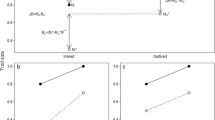Summary
The effects of a gametic disequilibrium (DSE) in an autotetraploid population on response to selection as measured by the covariance of selection were investigated. The theoretical responses were calculated for mass selection [Mass (1)] and half-sib progeny test selection (HSPT) in a two-allele (B and b), single locus, autotetraploid population. The complexity of calculations precluded analytical expressions for the covariances so numerical analysis was used assuming the following genetic models: monoplex dominance, partial monoplex dominance, duplex dominance, partial duplex dominance, and additive gene action.
The results indicated the DSE could greatly affect the covariance of selection. For a constant allele frequency the DSE might double the covariance expected with selection in a population at random mating equilibrium (RME) of gametes, but in other instances approach zero. For all genetic models and the two breeding methods investigated the covariance of selection was always increased when the frequency of BB gamete exceeded p2 (where p is frequency of allele B) and decreased when the frequency of BB gamete was less than p2. The possible incorporation of this information into a long term breeding program and some other ramifications were briefly discussed.
With the DSE the covariances of selection with HSPT and Mass (1) had a proportionality of 1:2, respectively, with the additive genetic model, but this relationship rarely occurred for other genetic models. The deviations from this ratio were not large in comparison to differences between selection in populations in DSE and RME.
Similar content being viewed by others
Literature
Demarly, Y. (1963): Genetique des tetraploides et amelioration des plants. Thesis. University of Paris
Falconer, D.S. (1960): Introduction to quantitative genetics. New York: Ronald Press
Hill, R.R., Jr. (1971): Effect of the number of parents on the mean and variance of synthetic varieties. Crop Sci. 11, 283–286
Hill, R.R., Jr.; Haag, W.L. (1974): Comparison of selection methods for autotetraploids. I. Theoretical. Crop Sci. 14, 587–590
Rowe, D.E.; Hill, R.R., Jr. (1981): Inter-population improvement procedures for alfalfa. Crop Sci. 21, 392–397
Author information
Authors and Affiliations
Additional information
Communicated by H. F. Linskens
Cooperative investigations of the Alfalfa Production Research Unit, United State Department of Agriculture, Agricultural Research Service, and the Nevada Agricultural Experiment Station, Reno, Nevada. Paper No. 512. Scientific Journal Series, Nevada Agricultural Experiment Station
Rights and permissions
About this article
Cite this article
Rowe, D.E. Effect of gametic disequilibrium on selection in an autotetraploid population. Theoret. Appl. Genetics 64, 69–74 (1982). https://doi.org/10.1007/BF00303654
Received:
Issue Date:
DOI: https://doi.org/10.1007/BF00303654




